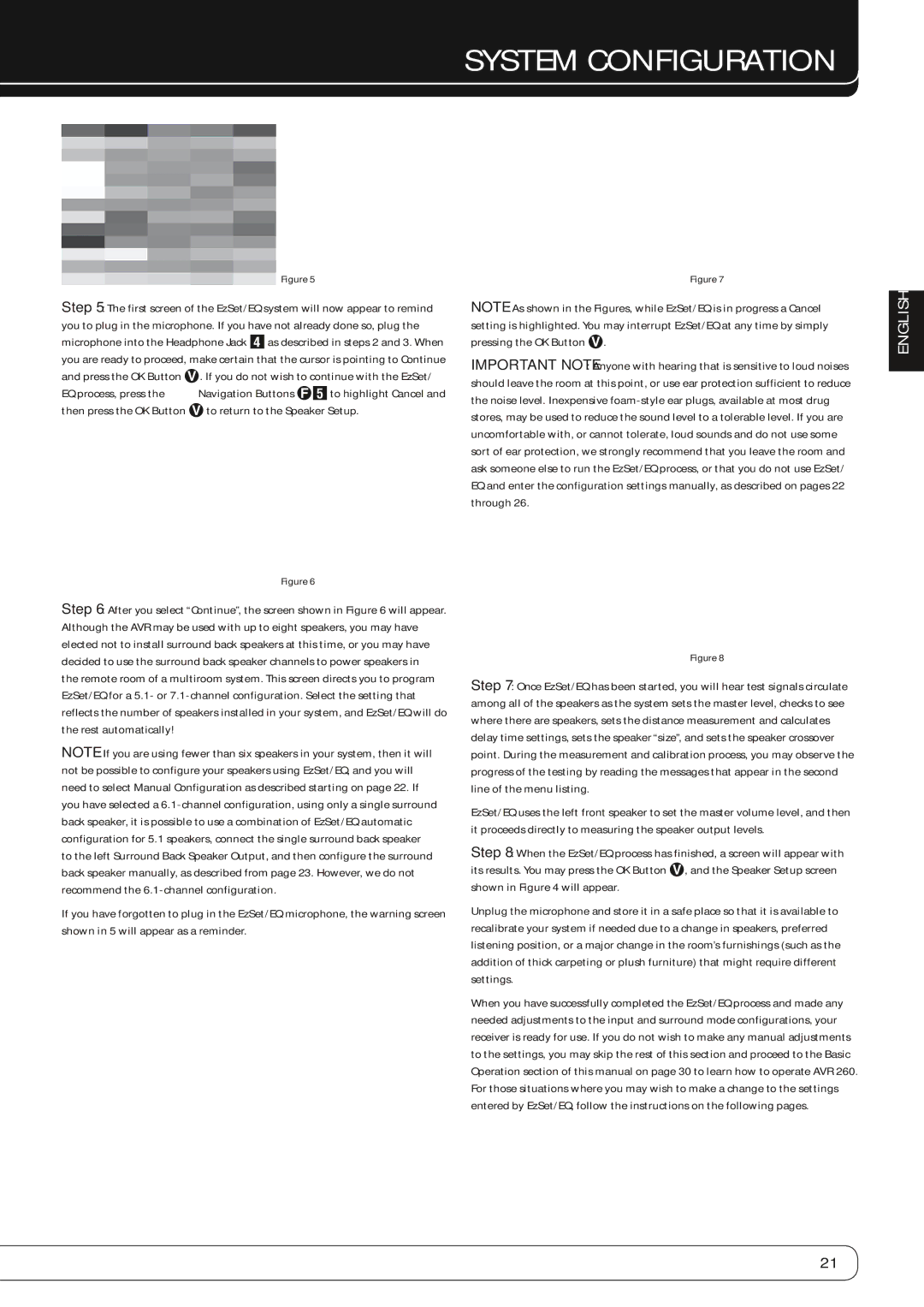
System Configuration
Figure 5
Step 5: The first screen of the EzSet/EQ system will now appear to remind you to plug in the microphone. If you have not already done so, plug the microphone into the Headphone Jack 3as described in steps 2 and 3. When you are ready to proceed, make certain that the cursor is pointing to Continue and press the OK Button V. If you do not wish to continue with the EzSet/ EQ process, press the KL Navigation Buttons F4to highlight Cancel and then press the OK Button Vto return to the Speaker Setup.
Figure 6
Step 6: After you select “Continue”, the screen shown in Figure 6 will appear. Although the AVR may be used with up to eight speakers, you may have elected not to install surround back speakers at this time, or you may have decided to use the surround back speaker channels to power speakers in
the remote room of a multiroom system. This screen directs you to program EzSet/EQ for a 5.1- or
NOTE: If you are using fewer than six speakers in your system, then it will not be possible to configure your speakers using EzSet/EQ, and you will need to select Manual Configuration as described starting on page 22. If you have selected a
to the left Surround Back Speaker Output, and then configure the surround back speaker manually, as described from page 23. However, we do not recommend the
If you have forgotten to plug in the EzSet/EQ microphone, the warning screen shown in 5 will appear as a reminder.
Figure 7
NOTE: As shown in the Figures, while EzSet/EQ is in progress a Cancel setting is highlighted. You may interrupt EzSet/EQ at any time by simply pressing the OK Button V.
IMPORTANT NOTE: Anyone with hearing that is sensitive to loud noises should leave the room at this point, or use ear protection sufficient to reduce the noise level. Inexpensive
Figure 8
Step 7: Once EzSet/EQ has been started, you will hear test signals circulate among all of the speakers as the system sets the master level, checks to see where there are speakers, sets the distance measurement and calculates delay time settings, sets the speaker “size”, and sets the speaker crossover point. During the measurement and calibration process, you may observe the progress of the testing by reading the messages that appear in the second line of the menu listing.
EzSet/EQ uses the left front speaker to set the master volume level, and then it proceeds directly to measuring the speaker output levels.
Step 8: When the EzSet/EQ process has finished, a screen will appear with its results. You may press the OK Button V, and the Speaker Setup screen shown in Figure 4 will appear.
Unplug the microphone and store it in a safe place so that it is available to recalibrate your system if needed due to a change in speakers, preferred listening position, or a major change in the room’s furnishings (such as the addition of thick carpeting or plush furniture) that might require different settings.
When you have successfully completed the EzSet/EQ process and made any needed adjustments to the input and surround mode configurations, your receiver is ready for use. If you do not wish to make any manual adjustments to the settings, you may skip the rest of this section and proceed to the Basic Operation section of this manual on page 30 to learn how to operate AVR 260. For those situations where you may wish to make a change to the settings entered by EzSet/EQ, follow the instructions on the following pages.
ENGLISH
21
